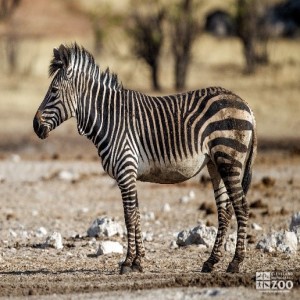 The Hartmann’s Mountain Zebra is a fairly large-sized donkey-like member of the horse family, with a narrow body and four fast growing one-toed hooves. The most distinct feature of the Mountain Zebra is its dewlap – a pendulous fold of skin under the throat, commonly associated with bovines and which is best developed in the male. They have black and white stripes all over their bodies except on their stomachs, which are a buff color which is also the color between the black stripes. There is a grid pattern on the rump which includes a series of short broad transverse stripes running perpendicular to the stripe on the animal’s side,that is not found on any other equine. The legs are striped to the hooves. The mane consists of short hairs that stand upright from the neck and the body stripes continue up through the mane. The tails on average are 20 inches in length with a tuft of hair at its end. The head is relatively short and striped, with a dark muzzle. Their ears are slender and reach up to 8 inches in length. The body length is about 7.3 feet and they stand at 4 to 4.5 feet in height. Their weight varies between 450 and 820 pounds. The Hartmann’s Mountain Zebra prefers to live in small groups of 7 to 12 individuals consisting of one adult male (stallion) and 1 to 5 adult females (mares). They are agile climbers, able to live in arid conditions in steep mountainous country
The Hartmann’s Mountain Zebra is a fairly large-sized donkey-like member of the horse family, with a narrow body and four fast growing one-toed hooves. The most distinct feature of the Mountain Zebra is its dewlap – a pendulous fold of skin under the throat, commonly associated with bovines and which is best developed in the male. They have black and white stripes all over their bodies except on their stomachs, which are a buff color which is also the color between the black stripes. There is a grid pattern on the rump which includes a series of short broad transverse stripes running perpendicular to the stripe on the animal’s side,that is not found on any other equine. The legs are striped to the hooves. The mane consists of short hairs that stand upright from the neck and the body stripes continue up through the mane. The tails on average are 20 inches in length with a tuft of hair at its end. The head is relatively short and striped, with a dark muzzle. Their ears are slender and reach up to 8 inches in length. The body length is about 7.3 feet and they stand at 4 to 4.5 feet in height. Their weight varies between 450 and 820 pounds. The Hartmann’s Mountain Zebra prefers to live in small groups of 7 to 12 individuals consisting of one adult male (stallion) and 1 to 5 adult females (mares). They are agile climbers, able to live in arid conditions in steep mountainous country
Location: African Savanna
Share:
Range
The Hartmann’s Mountain Zebra is native to the African coastal area of Namibia and southern Angola
Habitat
Dry, stony, mountain and hilly habitats. They prefer steep slopes and plateaus
Conservation Status
Vulnerable
Primary Threats
Human Wildlife Coexistence
Gestation
180 days
Litter
1
Behavior
The Hartmann’s Mountain Zebra prefers to live in small groups of 7-12 individuals. They are agile climbers. They are most active early in the morning and late afternoon and they spend half of the daylight hours feeding. They live in herds of one dominant adult stallion (male) and one to five mares (females) and their young. At times herds come together to form temporary groups of up to 30 individuals. During the winter, they move up to 20 kilometers (12 miles) from a water source. Where they are in danger of being hunted, so they tend to water at night. When not in danger they water at any time. They have excellent eyesight in the day and night. Their hearing is excellent as is their sense of taste
Reproduction
Foals weigh about 55 pounds at birth. Mares usually give birth to their first single foal between 3 and 6 years of age and then one foal for every 1 to 3 years until they are 24 years of age. The foals are nursed for up to one year. Like horses, zebras are able to stand, walk and suckle shortly after they are born. The Hartmann’s Mountain Zebra mother will force their male young out of the group when a new sibling is born after 1 year
Wild Diet
The diet consists of tufted grass, bark, leaves, fruit and roots. They often dig for water in the ground
Zoo Diet

